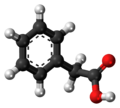Phenylacetic acid
Phenylacetic acid (PAA), also known as alpha-toluic acid, is an organic compound with the formula C6H5CH2COOH. It is a white, solid substance with a characteristic honey-like odor. Phenylacetic acid is classified as an aromatic carboxylic acid and is used in various chemical syntheses, including the production of pharmaceuticals, perfumes, and polymers.
Properties[edit]
Phenylacetic acid is slightly soluble in water but highly soluble in organic solvents such as ethanol, diethyl ether, and benzene. It has a melting point of 76.5-77.5 °C and a boiling point of 265.5 °C. The compound exhibits a strong absorption in the ultraviolet-visible spectrum, which is characteristic of aromatic compounds.
Synthesis[edit]
Phenylacetic acid can be synthesized through several methods. One common approach is the oxidation of ethylbenzene or benzyl chloride. Another method involves the hydrolysis of benzyl cyanide, which is a nitrile hydrolysis reaction.
Applications[edit]
Pharmaceuticals[edit]
Phenylacetic acid is a precursor in the synthesis of a variety of pharmaceuticals. It is used in the production of penicillin G, a widely used antibiotic, and phenylacetone, which is an intermediate in the synthesis of amphetamines. Its derivatives, such as phenylacetylglutamine, are excreted by humans after ingestion of phenylalanine, making it relevant in medical research and diagnostics.
Perfumery[edit]
In the perfumery industry, phenylacetic acid is valued for its honey-like odor. It is used as a fixative or an additive in the formulation of fragrances and flavorings.
Chemical Synthesis[edit]
Beyond its applications in pharmaceuticals and perfumery, phenylacetic acid serves as a starting material in the synthesis of various organic compounds. It is involved in the production of dyes, synthetic resins, and other polymers.
Safety and Regulation[edit]
Phenylacetic acid must be handled with care due to its potential health hazards. It can cause skin irritation and severe eye damage upon contact. Inhalation of its vapors can lead to respiratory irritation. Safety measures, including the use of personal protective equipment, are recommended when handling this chemical.
In some jurisdictions, phenylacetic acid is regulated due to its use as a precursor in the illicit synthesis of phenylacetone, which can be further processed into amphetamines. Regulations may include monitoring of its sale, distribution, and use.
See Also[edit]
Phenylacetic_acid[edit]
-
Structural formula of phenylacetic acid
-
Ball-and-stick model of phenylacetic acid
-
Synthesis of phenylacetic acid from benzyl cyanide
-
Phenylacetic acid
Ad. Transform your life with W8MD's Budget GLP-1 injections from $75


W8MD offers a medical weight loss program to lose weight in Philadelphia. Our physician-supervised medical weight loss provides:
- Weight loss injections in NYC (generic and brand names):
- Zepbound / Mounjaro, Wegovy / Ozempic, Saxenda
- Most insurances accepted or discounted self-pay rates. We will obtain insurance prior authorizations if needed.
- Generic GLP1 weight loss injections from $75 for the starting dose.
- Also offer prescription weight loss medications including Phentermine, Qsymia, Diethylpropion, Contrave etc.
NYC weight loss doctor appointmentsNYC weight loss doctor appointments
Start your NYC weight loss journey today at our NYC medical weight loss and Philadelphia medical weight loss clinics.
- Call 718-946-5500 to lose weight in NYC or for medical weight loss in Philadelphia 215-676-2334.
- Tags:NYC medical weight loss, Philadelphia lose weight Zepbound NYC, Budget GLP1 weight loss injections, Wegovy Philadelphia, Wegovy NYC, Philadelphia medical weight loss, Brookly weight loss and Wegovy NYC
|
WikiMD's Wellness Encyclopedia |
| Let Food Be Thy Medicine Medicine Thy Food - Hippocrates |
Medical Disclaimer: WikiMD is not a substitute for professional medical advice. The information on WikiMD is provided as an information resource only, may be incorrect, outdated or misleading, and is not to be used or relied on for any diagnostic or treatment purposes. Please consult your health care provider before making any healthcare decisions or for guidance about a specific medical condition. WikiMD expressly disclaims responsibility, and shall have no liability, for any damages, loss, injury, or liability whatsoever suffered as a result of your reliance on the information contained in this site. By visiting this site you agree to the foregoing terms and conditions, which may from time to time be changed or supplemented by WikiMD. If you do not agree to the foregoing terms and conditions, you should not enter or use this site. See full disclaimer.
Credits:Most images are courtesy of Wikimedia commons, and templates, categories Wikipedia, licensed under CC BY SA or similar.
Translate this page: - East Asian
中文,
日本,
한국어,
South Asian
हिन्दी,
தமிழ்,
తెలుగు,
Urdu,
ಕನ್ನಡ,
Southeast Asian
Indonesian,
Vietnamese,
Thai,
မြန်မာဘာသာ,
বাংলা
European
español,
Deutsch,
français,
Greek,
português do Brasil,
polski,
română,
русский,
Nederlands,
norsk,
svenska,
suomi,
Italian
Middle Eastern & African
عربى,
Turkish,
Persian,
Hebrew,
Afrikaans,
isiZulu,
Kiswahili,
Other
Bulgarian,
Hungarian,
Czech,
Swedish,
മലയാളം,
मराठी,
ਪੰਜਾਬੀ,
ગુજરાતી,
Portuguese,
Ukrainian




